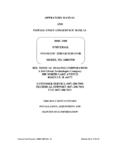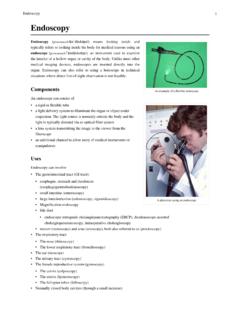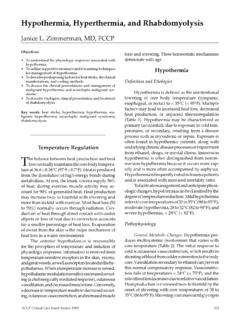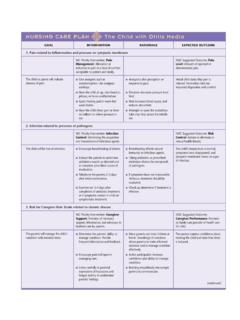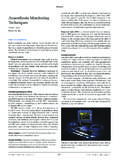Transcription of Normal human body temperature - Frank's Hospital …
1 Normal human body temperature1 Normal human body temperatureNormal human body temperature , also known as normothermia or euthermia, is a concept that depends upon theplace in the body at which the measurement is made, and the time of day and level of activity of the person. There isno single number that represents a Normal or healthy temperature for all people under all circumstances using anyplace of parts of the body have different temperatures . Rectal and vaginal measurements, or measurements takendirectly inside the body cavity, are typically slightly higher than oral measurements, and oral measurements aresomewhat higher than skin temperature . The commonly accepted average core body temperature (taken internally) C ( F). The typical oral (under the tongue) measurement is slightly cooler, at C, F.[1] [2] In Russia and former Soviet countries, the commonly quoted value is C ( F), based onan armpit (axillary) reading.
2 Although some people think of these numbers as representing the Normal temperature , awide range of temperatures has been found in healthy people.[3] In samples of Normal adult men and women, theobserved range for oral temperature is C (92 101 F), for rectal it is C (94 100 F), for thetympanic cavity it is C (96 100 F) and for axillary it is C (96 99 F).[4]Variations in body temperature are part of the circadian rhythm (see at 4:30 and 19:00).The time of day and othercircumstances also affects the body 'stemperature. The core bodytemperature of an individual tends tohave the lowest value in the secondhalf of the sleep cycle; the lowestpoint, called the nadir, is one of theprimary markers for circadian body temperature also changeswhen a person is hungry, sleepy, the early 18th century, Gabriel Fahrenheit originally used human body temperature as a reference point for histemperature scale, defining it to be 100 F.
3 Later redefinition of his scale to use the boiling point of water as areference point caused the numerical value for Normal body temperature to 1861, Carl Reinhold August Wunderlich released his summary of the armpit, or axillary, temperatures of twentyfive thousand people, and reported the mean to be C ( F), with a range of C ( F) to C( F)[5] [1] . He also identified the natural variations in temperature throughout the day and the variationsbetween individuals, as well as differences based on sex and age, which were largely ignored in favor of anoversimplified single number.[6] Wunderlich's thermometers were not calibrated to a standard setting in 1861, nostandard had been agreed upon and he never explained his methods for compiling and describing the data he hadcollected, which would have been a monumental task before the availability of basic calculating machines.
4 [6] Theone surviving, hand-made thermometer reads significantly higher than modern thermometers.[6] Normal human body temperature2 VariationsDiurnal variation in body temperature , ranging from about Cfrom 10 to 6 , and falling to about C from 2 to control (thermoregulation) is part of ahomeostatic mechanism that keeps the organism atoptimum operating temperature , as it affects the rate ofchemical reactions. In humans the average oraltemperature is C ( F), though it variesamong individuals. However, no person always hasexactly the same temperature at every moment of theday. temperatures cycle regularly up and downthrough the day, as controlled by the person's circadianrhythm. The lowest temperature occurs about two hoursbefore the person normally wakes up. Additionally, temperatures change according to activities andexternal factors.
5 [7] Normal body temperature may differ as much as C ( F) from day to rhythmsBody temperature normally fluctuates over the day, with the lowest levels around 4 and the highest in the lateafternoon, between 4:00 and 6:00 [1] [8] (assuming the person sleeps at night and stays awake during the day).Therefore, an oral temperature of C ( F) would, strictly speaking, be Normal in the afternoon but not in themorning. An individual's body temperature typically changes by about C ( F) between its highest and lowestpoints each day.[1] body temperature is sensitive to many hormones, so women have a temperature rhythm that varies with themenstrual cycle, called a circamensal rhythm.[7] A woman's basal body temperature rises sharply after ovulation, asestrogen production decreases and progesterone increases. Fertility awareness programs use this predictable changeto identify when a woman is able to become pregnant.
6 During the luteal phase of the menstrual cycle, both the lowestand the average temperatures are slightly higher than during other parts of the cycle. However, the amount that thetemperature rises during each day is slightly lower than typical, so the highest temperature of the day is not verymuch higher than usual.[6] Hormonal contraceptives both suppress the circamensal rhythm and raise the typical bodytemperature by about C ( F).[7] temperature also varies with the change of seasons during each year. This pattern is called a circannual rhythm.[6]Studies of seasonal variations have produced inconsistent results. People living in different climates may havedifferent seasonal physical fitness increases the amount of daily variation in temperature .[6]With increased age, both average body temperature and the amount of daily variability in the body temperature tendto decrease.[6] Elderly patients may have a decreased ability to generate body heat during a fever, so even asomewhat elevated temperature can indicate a serious underlying cause in human body temperature3 Variations due to measurement methodsDifferent methods used for measuring temperature produce different , oral, rectal, gut, and core body temperatures , although slightly different, are well-correlated, with oraltemperature being the lowest of the temperatures are influenced by drinking, chewing, smoking, and breathing with the mouth open.
7 Cold drinks orfood reduce oral temperatures ; hot drinks, hot food, chewing, and smoking raise oral temperatures .[7]Axillary (armpit), tympanic (ear), and other skin-based temperatures correlate relatively poorly with core bodytemperature.[6] Tympanic measurements run higher than rectal and core body measurements, and axillarytemperatures run lower.[6] The body uses the skin as a tool to increase or decrease core body temperature , whichaffects the temperature of the skin. Skin-based temperatures are more variable than other measurement sites.[6] Thepeak daily temperature for axillary measurements lags about three hours behind the rest of the body .[6] Skintemperatures are also more influenced by outside factors, such as clothing and air due to outside factorsMany outside factors affect the measured temperature as well. " Normal " values are generally given for an otherwisehealthy, non-fasting adult, dressed comfortably, indoors, in a room that is kept at a Normal room temperature ( C or 73 to 76 F), during the morning, but not shortly after arising from sleep.
8 Furthermore, for oraltemperatures, the subject must not have eaten, drunk, or smoked anything in at least the previous fifteen to twentyminutes, as the temperature of the food, drink, or smoke can dramatically affect the is increased after eating or drinking anything with calories. Caloric restriction, as for a weight-loss diet,reduces overall body temperature .[7] Drinking alcohol reduces the amount of daily change, slightly lowering daytimetemperatures and noticeably raising nighttime temperatures .[7]Exercise raises body temperatures . In adults, a noticeable increase usually requires strenuous exercise or exercisesustained over a significant time. Children develop higher temperatures with milder activities, like factors also influence body temperature : a very excited person often has an elevated more clothing slows daily temperature changes and raises body temperature .[7] Similarly, sleeping with anelectric blanket raises the body temperature at night.
9 [7]Sleep disturbances also affect temperatures . Normally, body temperature drops significantly at a person's normalbedtime and throughout the night. Short-term sleep deprivation produces a higher temperature at night than Normal ,but long-term sleep deprivation appears to reduce temperatures .[7] Insomnia and poor sleep quality are associatedwith smaller and later drops in body temperature .[7] Similarly, waking up unusually early, sleeping in, jet lag andchanges to shift work schedules may affect body temperature .[7]Specific temperature conceptsFeverA temperature setpoint is the level at which the body attempts to maintain its temperature . When the setpoint israised, the result is a fever. Most fevers are caused by infectious disease and can be lowered, if desired, withantipyretic organism at optimum temperature is considered afebrile or apyrexic, meaning "without fever".
10 If temperature israised, but the setpoint is not raised, then the result is human body temperature4 HyperthermiaHyperthermia occurs when the body produces or absorbs more heat than it can dissipate. It is usually caused byprolonged exposure to high temperatures . The heat-regulating mechanisms of the body eventually becomeoverwhelmed and unable to deal effectively with the heat, causing the body temperature to climb at or above about 40 C (104 F) is a life-threatening medical emergency that requires immediatetreatment. Common symptoms include headache, confusion, and fatigue. If sweating has resulted in dehydration,then the affected person may have dry, red a medical setting, mild hyperthermia is commonly called heat exhaustion or heat prostration; severe hyperthermiais called heat stroke. Heat stroke may come on suddenly, but it usually follows the untreated milder involves cooling and rehydrating the body ; fever-reducing drugs are useless for this condition.
